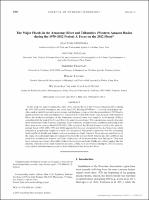Mostrar el registro sencillo del ítem
The Major Floods in the Amazonas River and Tributaries (Western Amazon Basin) during the 1970-2012 Period: A Focus on the 2012 Flood
| dc.contributor.author | Espinoza, J.C. | |
| dc.contributor.author | Ronchail, J. | |
| dc.contributor.author | Frappart, F. | |
| dc.contributor.author | Lavado-Casimiro, W. | |
| dc.contributor.author | Santini, W. | |
| dc.contributor.author | Guyot, J.L. | |
| dc.date.accessioned | 2019-07-26T06:29:23Z | |
| dc.date.available | 2019-07-26T06:29:23Z | |
| dc.date.issued | 2013 | |
| dc.identifier.uri | https://hdl.handle.net/20.500.12542/63 | |
| dc.description.abstract | In this work, the authors analyze the origin of the extreme floods in the Peruvian Amazonas River during the 1970-2012 period, focusing on the recent April 2012 flooding (55400m3 s-1). Several hydrological variables, such as rainfall, terrestrial water storage, and discharge, point out that the unprecedented 2012 flood is mainly related to an early and abundant wet season over the north of the basin. Thus, the peak of the Marañón River, the northern contributor of the Amazonas, occurred sooner than usual (in April instead of May), coinciding with the peak of the Ucayali River, the southern contributor. This concomitance caused a dramatic flood downstream in the Peruvian Amazonas. These results are compared to the amplitude and timing of the three most severe extreme floods (1970-2011). The analysis of the climatic features related to the most important floods (1986, 1993, 1999, and 2012) suggests that they are characterized by a La Ni~na event, which originates a geopotential height wave train near the ground, with positive anomalies over the subtropical South and North Pacific and Atlantic and over southeastern South America. These patterns contribute to 1) the origin of an abundant humidity transport flux from the tropical North Atlantic and the Caribbean Sea toward the northwestern Amazon and 2) the maintenance of the monsoon flux over this region. They both favor a strong convergence of humidity in the northern Amazonas basin. Finally, the authors suggest that the intensity of floods is more likely related to an early La Niña event (as observed during the 2011/12 season), early rainfall, and simultaneous peaks of both tributaries of the Amazonas River. | en_US |
| dc.format | application/pdf | |
| dc.language.iso | eng | en_US |
| dc.publisher | American Meteorological Society | en_US |
| dc.relation.ispartof | urn:issn:1525-755X | |
| dc.rights | info:eu-repo/semantics/openAccess | en_US |
| dc.rights | Atribución-NoComercial-SinDerivadas 3.0 Estados Unidos de América | * |
| dc.rights.uri | http://creativecommons.org/licenses/by-nc-nd/3.0/us/ | * |
| dc.source | Servicio Nacional de Meteorología e Hidrología del Perú | |
| dc.source | Repositorio Institucional - SENAMHI | |
| dc.subject | Amplitude | en_US |
| dc.subject | Flooding | en_US |
| dc.subject | Geopotential | en_US |
| dc.subject | Monsoon | en_US |
| dc.subject | Rainfall | en_US |
| dc.subject | Rios | es_PE |
| dc.title | The Major Floods in the Amazonas River and Tributaries (Western Amazon Basin) during the 1970-2012 Period: A Focus on the 2012 Flood | en_US |
| dc.type | info:eu-repo/semantics/article | |
| dc.identifier.isni | 0000 0001 0746 0446 | |
| dc.description.peerreview | Por pares | |
| dc.identifier.doi | https://doi.org/10.1175/JHM-D-12-0100.1 | |
| dc.source.volume | 14 | en_US |
| dc.source.issue | 3 | en_US |
| dc.source.initialpage | 1000 | en_US |
| dc.source.endpage | 1008 | en_US |
| dc.source.journal | Journal of Hydrometeorology | en_US |
| dc.subject.sinia | inundaciones - Clima y Eventos Naturales | |
| dc.type.sinia | text/publicacion cientifica | |
| dc.identifier.url | https://hdl.handle.net/20.500.12542/63 |
Ficheros en el ítem
Este ítem aparece en la(s) siguiente(s) colección(es)
-
Artículo científico [171]








